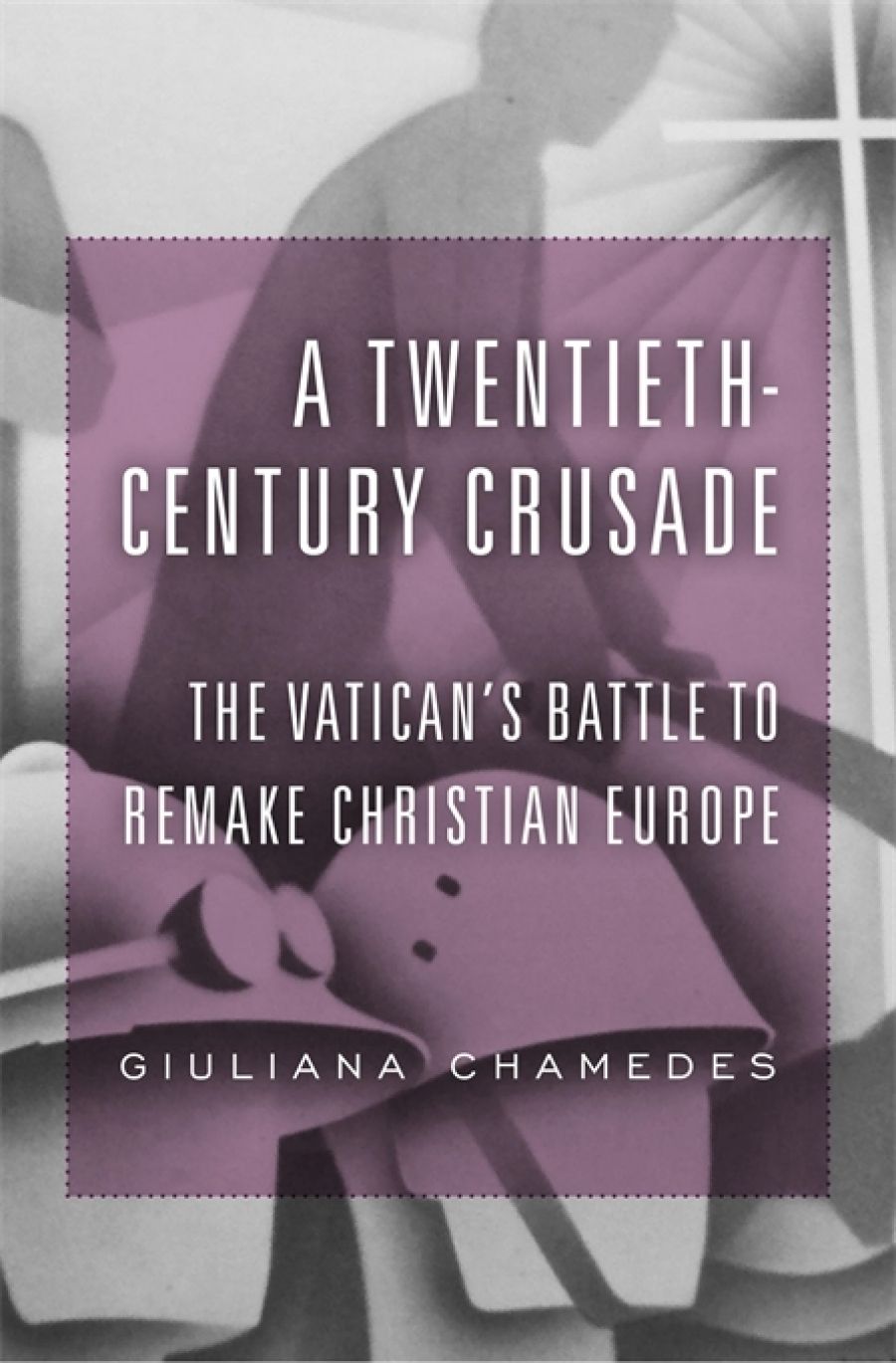
- Free Article: No
- Contents Category: Religion
- Review Article: Yes
- Custom Highlight Text:
The papacy’s role in international affairs is often underestimated. A recent example is Pope Francis’s participation in the 2015 negotiations leading to a détente between Cuba and the United States. It helped, of course, that Barack Obama was president and that Raúl Castro had replaced his brother Fidel in Havana; but it was Francis, building on the work of his predecessors who had maintained continuous relations with the Castro regime, who brought the two sides together, and who persuaded the United States to drop its sanctions against Cuba.
- Grid Image (300px * 250px):

- Book 1 Title: A Twentieth-Century Crusade
- Book 1 Subtitle: The Vatican’s battle to remake Christian Europe
- Book 1 Biblio: Harvard University Press (Footprint) $85 hb, 432 pp
Giuliana Chamedes’s A Twentieth-Century Crusade recognises the importance of Vatican diplomacy. Her focus is on Vatican internationalism in Europe between World War I and the Second Vatican Council of the 1960s. She argues that, according to the papal analysis, the Great War was the result of the decline of church influence in European public life. Throughout this period, papal policy was centred on re-establishing a kind of pope-focused Catholicism, while attempting to eliminate the influence of both communism and secular-liberal democracy.
As the popes saw it, the key to maintaining a ‘uniquely Catholic international European order’ was the concordat, a binding agreement between church and state that guaranteed that human society was based ‘on the solid ground of Christian justice and Christian law’: in other words, a confessional state in which the law, particularly in matters of marriage, divorce, and education, would be in line with papal teachings. The ultimate aim was to have Catholicism declared the state religion with other faiths relegated to second-class status. The notion of a secular, let alone atheist, state was anathema.
 Portrait of Pope Venerable Pius XII (photograph by Michael Pitcairn/Wikimedia Commons)
Portrait of Pope Venerable Pius XII (photograph by Michael Pitcairn/Wikimedia Commons)
The great champion of concordats was Eugenio Pacelli, who was successively nuncio in Bavaria, then Berlin, and, from early 1930, papal secretary of state. He was elected pope as Pius XII in March 1939. It was Pacelli who negotiated the disastrous Reichskonkordat in July 1933 with the newly elected Hitler, giving the Führer the international respectability he craved, while achieving little to protect German Catholics.
Papal policy, characterised by Chamedes as a ‘crusade’, was successful when it coincided with the aims of dictators like Mussolini, Hitler, Augustinas Voldemaras in Lithuania, and Franco in Spain. At the heart of this crusade was the attack on communism. The opening salvo was Pius XI’s encyclical Quadragesimo anno (1931), which was as critical of capitalism as it was of socialism and communism. But it was the encyclical’s anti-communist stance that many Catholics embraced. In Australia, it was this encyclical that first influenced Bob Santamaria’s deep-seated anti-communism and his unsympathetic assessment of capitalism.
One of Chamedes’s unique discoveries is the Vatican’s Secretariat on Atheism, a body that has been neglected by historians. It led the papal assault on communism by employing all available media, including using travelling exhibitions, sponsoring radio programs (Marconi opened Vatican Radio in 1931), publishing journals, and even promoting novel-writing contests and film scripts. It also worked with other anti-communist elements, including fascists, Nazis, and right-wingers in Europe and North America. But Chamedes also shows that there was articulate opposition within Catholicism to Vatican policies on church–state relations and religious freedom. Italian priest and politician Luigi Sturzo, French philosopher Jacques Maritain, and US theologian John Courtney Murray opposed the notion of the confessional state and spoke out in favour of democracy and pluralism.
While the Vatican maintained the crusade until Pius XII’s death in 1958, postwar Catholic leaders like West Germany’s Konrad Adenauer and Alcide De Gasperi in Italy were not interested in establishing confessional states. After the deaths of António Salazar in 1970 and Francisco Franco in 1975, Portugal and Spain, the last two autocratic Catholic strongholds, embraced democracy and pluralism. The church itself jettisoned confessionalism in the Vatican II decree Dignitatis humanae (1965), which unequivocally accepted the separation of church and state and the right of everyone to conscientious religious freedom.
Chamedes’s book is an important addition to papal studies. However, by limiting her purview to Europe she misses the real struggle that was occurring within Catholicism. It’s true that until Vatican II the popes supported the confessional state in majority Catholic countries because this was the ‘natural order’ of things. ‘Error has no rights’ was the catchcry. But in democratic countries like Australia, where Catholics were in a minority, Rome reverted to realpolitik by accepting a reality it could not change. It was Murray who highlighted the double standard promoted by a doctrine whereby what was ‘heresy’ in one country was acceptable in another. Murray also showed that there was a more ancient tradition that went back to Pope Gelasius I (492–96 ce) who spoke of ‘two powers by which the world is ruled’: the sacred and secular. The irony is that separation of church and state is rooted in this ancient Gelasian tradition. Murray also showed that ‘error has no rights’ was meaningless nonsense. While Chamedes briefly mentions Murray, her book would have been strengthened if she had tackled this theological debate. In fact, the one important thing missing from the book is a serious engagement with the underlying theological issues.
The popes had inherited the medieval notion of church and state as two sides of the same coin. This was reinforced by the First Vatican Council (1870) when it defined papal primacy, essentially making the pope dictator of the church. This crude theology was only finally abandoned at Vatican II, when Catholicism eventually caught up with twentieth-century reality.


Comments powered by CComment